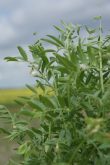With lentil acreages expected to be up this year, getting on top of any anthracnose infestation early and with the latest tools should be top of mind for producers, says Kate Hadley, a marketing agronomist with Bayer.
“Lentil acres are going to be up over last year,” Hadley said.
“It seems like everyone’s seeding some lentils this year.”
Read Also

Saskatchewan puts crown land auction on hold
Auctions of Saskatchewan crown lease land are once again on hold.
Anthracnose pops up fairly early, which makes sense, because it’s not necessarily a seed-borne disease but comes from infected residue. Like most fungi, it likes moist conditions, and a rain splash on infected residue will bring it up onto the stem and into the leaves. This spring may be a good test for it in the field because there has actually been a fair amount of spring rain already.
“For lentils, we typically recommend either spraying at the first sign of disease or right at flowering, whichever comes first,” Hadley said.
“With fungicides, we want to apply preventively, so we don’t want to see a lot of infection on that plant and hope for curative activity. Most fungicide active ingredients work better if they are applied preventatively.
“Also, something to think about with lentils is that they’re fairly small plants but they’re pretty dense. If we wait too long, it’s hard to get that spray to provide good coverage for that whole plant. “You need high water volumes and high pressure to get down into that foliage, whereas spraying them a little bit earlier makes it easier to get the product to completely cover that lentil plant.”
Bayer has just released an upgraded version of its Delaro fungicide product, Delaro Complete. The new formulation adds a Group 7 active ingredient, fluopyram, to hit anthracnose with three modes of action.
“We haven’t seen any breakthrough problems with the original Delaro formulation, but keeping in mind some best practices for resistance management, we’ve added another effective mode of action,” Hadley said.
The other two active ingredients include a Group 11 (trifloxystrobin) and a Group 3 (prothioconazole). The Group 11 hits the mitochondria, the energy plants within the cells of the fungus, and jams up their ability to take in oxygen and release carbon dioxide. If they can’t do that, the fungus dies.
The Group 3 goes after the fungal cell membrane and prevents growth.
So far, the combination has been an effective way to slow down invading anthracnose. Fluopyram also goes after respiration but at a different site in the mitochondria.
In the past, anthracnose, and other fungal pathogens developed insensitivity to fungicides that used a single Group 11 chemistry.
“We saw that in chickpeas with ascochyta blight almost 20 years ago,” said University of Saskatchewan plant pathologist Sabine Banniza.
She said fungal diseases can more easily develop resistance to fungicides with only one mode of action because they act on only one gene.
“With only one specific gene affected, there is a very high probability that natural mutation happens in these fungal populations. All of a sudden, you have individuals where this specific gene is not important anymore. The result is that they become insensitive to the fungicide.”
Insensitive individuals breed insensitive populations, and the result is a fungicide that eventually has little or no effect.
Fungicide products with more than one active ingredient make it more unlikely for the pathogen to develop resistance. Give the anthracnose gene pool one problem to solve, it does it fairly quickly and your fungicide becomes ineffective. Throwing two other active ingredients at it gives it three problems to solve all at once, and that takes a lot more time.
“You want to increase the number of modes of action and make sure that any fungus with resistance to one of them is taken out by the other.
“That’s why companies have tried to combine active ingredients because it may not eliminate the risk, but it will slow it down.
“Previous fungicides contained only Group 11s, and we used those repetitively on the same crop year after year. That exerted a lot of selection pressure, specifically with anthracnose.”
Making matters worse is that anthracnose is a polycyclic disease, which means it has several generations in one season, providing more chances for a fungicide-insensitive strain to emerge from all that selection pressure. She said it’s probably why we’ve seen insensitive anthracnose pop up in treated lentil fields.
Registration for Delaro Complete came through last summer, so this will be the first year it is available for growers, although they may have seen it at some of the trade shows over the winter. Hadley said they demonstrated the product in lentil fields last year.
“It was fairly dry, but Delaro Complete did a great job then,” she said.
“Even in our research and development trials, where we’ve had more moisture and better disease conditions, it’s been a great product for us. We have tested it in small plot, high disease environments and, even in dry years, we are seeing an increase in yield compared to the untreated check. That’s at least covering the cost of the application, if not making you money.”















